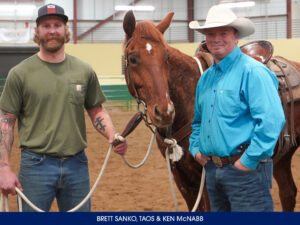Written by: Brett Sanko, Equine Trainer
Edited by: Megan Goheen, Marketing Associate
How would you explain natural horsemanship?
Natural horsemanship is all about creating an environment where the trainer and the horse are communicating in the same language. To accomplish this, the trainer needs to understand herd dynamics and comprehend how horses learn naturally. This is done at the fundamental level as pressure and release. The pressure is applied in the form of body language. For example, the head mare in a herd will determine where to move the herd by using cues from her body to make the rest of the herd move their feet. If she grazes peacefully, her herd is calm. If she lifts her head, pricks her ears forward, and tightens her muscles, the herd knows it is time to move. To make sure they are listening to her, she may flatten her ears and take a step toward a herd individual. In this case, the horse should know to move away. Once completed, the lead mare will return to a relaxed state. Hence, releasing the pressure.
Similarly, a trainer needs to utilize his or her body language to effectively direct a horse in accomplishing a task. By maintaining fairness and consistency in cues, the trainer can successfully guide the horse to complete a desired objective.
Why is it important to build a community around horsemanship?
In my opinion, Ken McNabb excels at this. During the clinic, he created a positive learning environment for riders of all abilities and disciplines, with a strong emphasis on prioritizing the fundamentals of natural horsemanship.
When you dig down into the weeds, natural horsemanship builds good riding, whether it’s English or Western. With a shared understanding among riders, there can be more collaboration between disciplines. This collaboration allows recognition of strengths in each discipline; for instance, English riders may excel in posture, while Western riders do a great job developing durability in their horses. By understanding each strong suit, riders in each discipline can learn from one another.

How are Ken McNabb’s training methods like CHR’s?
Ken and CHR both use natural horsemanship. We both focus on what is best for the horses. This is accomplished by training softness and confidence into horses. It helps the horses want to participate while also building their physique and structure, keeping them healthy.
What was the biggest take away from the clinic?
I really liked Ken’s mantra “intensity plus consistency equals progress.” Intensity does not mean drilling a horse until they are about to collapse but rather pushing them just past their comfort zone so that they can grow and become more comfortable with new things. Consistency is the key factor. Consistent cues in everything a trainer or rider does helps a horse avoid confusion and frustration which can lead the horse to unravel.
I hear that you enjoy horseback camping trips. How are you going to apply what you learned at the clinic to the next time you head out on a trip?
Consistently applying the fundamentals of natural horsemanship is key. Whether it’s achieving softness in a horse’s head, getting them to bend properly, or venturing into the mountains, understanding how a horse naturally wants to interact with its herd is crucial when introducing them to new skills. By using Ken’s mantra of “intensity plus consistency equals progress,” the approach unfolds gradually—from initial rides around the property to shorter trips, steadily building the horse’s durability, and finally out into the mountains.
